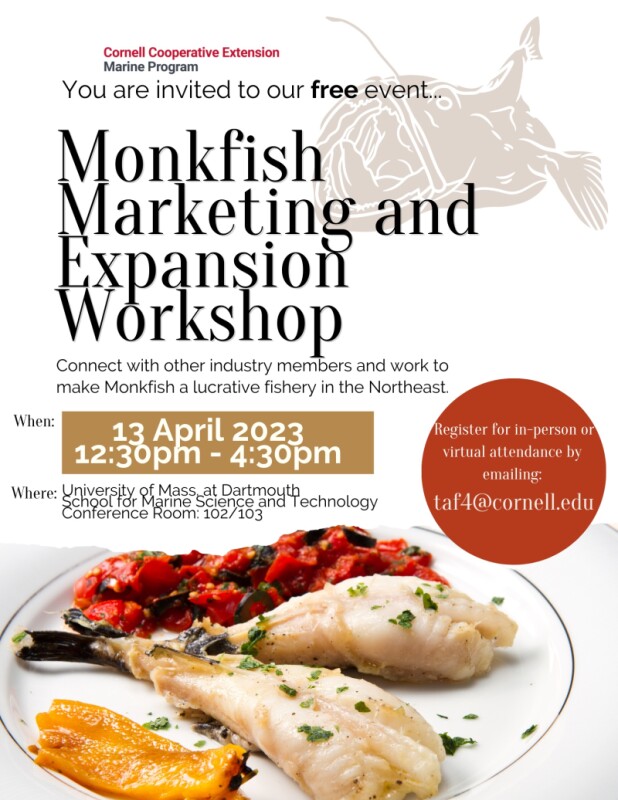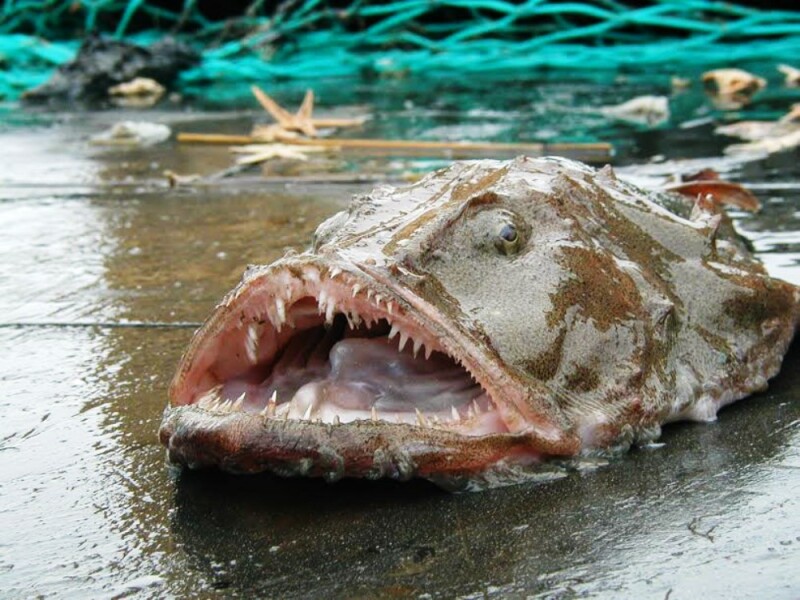From the first time television chef Julia Child hoisted a whole, ugly monkfish in front of her audience, early successes in marketing “the poor man’s lobster” showed how creative culinary and marketing campaigns could boost underutilized U.S. fisheries.
Now a new collaborative program aims to again boost domestic demand for monkfish – a stock at high population levels, and accessible close to home for Atlantic fishermen. Extending from Maine to New Jersey, it’s a regional push to “expand the audience and the markets that monkfish can fill,” said Tara McClintlock, a fisheries specialist with the Cornell Cooperative Marine Extension Service in New York.
The Cornell Cooperative Extension program based in Suffolk County on Long Island is leading the project, funded by the annual federal Saltonstall-Kennedy grant program through the National Oceanic and Atmospheric Administration. This winter the project team surveyed all levels of the industry, from fishermen and dealers to restaurants to get a sense of the market for monkfish, and how it could get boosted.

The organizers will present their early findings April 13 during a workshop at the University of Massachusetts Dartmouth School for Marine Science & Technology in New Bedford, Mass.
“It’s mostly to get all our partners together, along with other people who have jumped on and are excited to promoted monkfish,” said Amanda Dauman, a fisheries specialist with the Cornell extension service.
Today monkfish are still plentiful, and promoters hope to light that fuse again.
“It’s a really good fish, it’s local, it’s healthy, it’s sustainable,” said Dauman. “All of those things that people want to hear.”
A staple of seafood cuisine in western Europe, known as lotte in France, monkfish was generally considered trash in East Coast trawl fisheries, although with limited ethnic markets. Child’s The French Chef television series on public television helped broaden that horizon, with episodes showing how to tackle the intimidating, toothy animal that old-time fishermen called goosefish or “allmouth.”
By the early 1990s the boost in domestic sales brought more monkfish to the docks, and attention from buyers for other markets in Asia. Monkfish liver, prized in Japanese cuisine as ankimo, was packaged for export, along with whole, head-on monkfish for freezing and sale to South Korea.
Domestic monkfish sales had been falling even before covid-19 erupted in early 2020, and exports fell victim to the overall mayhem as international markets locked up. Cornell fisheries specialists have long worked with fishermen and witnessed the drop.
“The price of the fresh market has been declining for years,” said McClintlock. Meanwhile after the disruptions of covid-19, fishermen say “Chinese monkfish has replaced some of the U.S. product” in the Asia export market, she added.
“When you’re totally dependent on export sales, it’s a disaster when something happens,” said Colleen Coyne, coordinator of the Food Export-Northeast's Seafood Program.
The survey team visited in person at the Fulton seafood market in New York City, and visited with monkfish suppliers and retailers in New Bedford, Mass., Rhode Island and Boston. The Cornell marketing group regularly does media promotion in the New York region and will look to connect the monkfish project with high-end New York City restaurants and chefs.
On-the-ground promotional efforts could help. The Cornell extension sponsors a program called “Cook a Fish, Give a Fish” that produces online cooking classes that raise money to benefit communities in need, and incorporated monkfish into that menu.
The team is looking to interest school food programs and institutional buyers like universities and hospitals in monkfish for food service.
New retail ideas are another attractive target, including value-added products. Some ideas already winning with consumers are bacon-wrapped medallions, chowders and Chatham monkfish mac and cheese popularized on Cape Cod.
The Cornell Cooperative Extension has planned out the monkfish program to run two years working with fishermen, dealers and processors on marketing in the Atlantic region. Public outreach events will use information booths and local seafood tastings to get consumers familiar with monkfish.
“Regionwide success in this regard will not only breathe life into a once-lucrative fishery, but also support local fishermen and businesses, reduce the carbon footprint, and reduce commercial fishing pressure on other heavily fished sought-after species,” the Cornell team says in its pitch to the industry and consumers. “With so many potential benefits attached to monkfish, this may very well be the golden goose that Northeast’s commercial fishery needs.”








